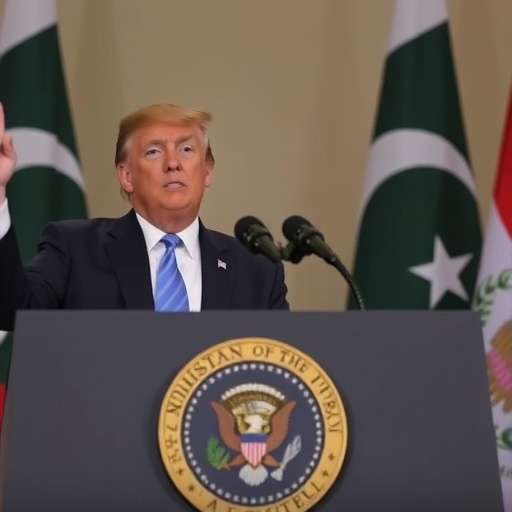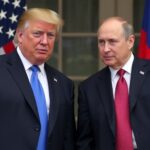Trump Praises Pakistani Leaders Shehbaz Sharif and Asim Munir, Vows Rapid Resolution to Afghanistan-Pakistan Border Crisis
In a surprising diplomatic overture, former President Donald Trump has publicly commended Pakistani Prime Minister Shehbaz Sharif and Army Chief General Asim Munir, while pledging his commitment to swiftly resolve the escalating tensions between Pakistan and Afghanistan. This statement, delivered during a recent virtual address to international stakeholders, marks a notable shift in rhetoric amid ongoing border skirmishes and cross-border militancy that have plagued the region for years.
Trump‘s words come at a critical juncture, as clashes along the Durand Line—the contentious 2,640-kilometer border separating the two nations—have intensified, displacing thousands and raising fears of a broader regional conflict. Drawing on his past experiences in South Asian diplomacy, Trump emphasized the need for immediate U.S. involvement to broker peace, invoking his previous administration’s efforts in Afghanistan negotiations.
Trump’s Direct Praise Echoes Past Alliances
During his address, Trump singled out Shehbaz Sharif and Asim Munir for their leadership in navigating Pakistan’s complex security landscape. ‘Prime Minister Sharif and General Munir are doing a tremendous job under very tough circumstances,’ Trump stated, according to transcripts released by his team. ‘Pakistan has been a key partner in the fight against terrorism, and it’s time we reward that loyalty with real action.’
This praise is not without historical context. During Trump’s presidency from 2017 to 2021, U.S.-Pakistan relations experienced highs and lows, particularly in the context of the Afghanistan war. Trump famously suspended $300 million in military aid to Pakistan in 2018, accusing Islamabad of harboring militants. However, by 2020, ties warmed as Pakistan facilitated talks between the U.S. and the Taliban, leading to the Doha Agreement that paved the way for the U.S. withdrawal from Afghanistan.
Shehbaz Sharif, who assumed office in April 2022 following a contentious no-confidence vote against Imran Khan, has focused on economic stabilization and counter-terrorism. Under his leadership, Pakistan has conducted operations against Tehrik-i-Taliban Pakistan (TTP) militants, who have reportedly found safe havens in Afghanistan post-2021 Taliban takeover. General Asim Munir, appointed Army Chief in November 2022, has been instrumental in these efforts, overseeing military deployments along the Afghan border and advocating for stronger intelligence-sharing with international partners.
Trump’s endorsement could signal a potential revival of U.S. support. In 2023 alone, Pakistan reported over 500 terrorist incidents linked to cross-border activities, according to the South Asia Terrorism Portal, underscoring the urgency of Trump’s vow.
Spotlight on the Afghanistan-Pakistan Border Flashpoints
The Afghanistan-Pakistan conflict traces its roots to the porous Durand Line, drawn in 1893 by British colonial authorities and never fully accepted by Kabul. Tensions have flared repeatedly, but the situation deteriorated sharply after the Taliban’s return to power in August 2021. Afghanistan, under Taliban rule, has been accused by Pakistan of sheltering anti-Pakistani militants, including the TTP, which has claimed responsibility for attacks killing over 200 security personnel in the past year.
Recent incidents include artillery exchanges in March 2024 near Bajaur district, where Pakistani forces shelled alleged militant hideouts in Afghanistan’s Kunar province, resulting in civilian casualties on both sides. The United Nations has documented over 100,000 displacements in border areas since 2022, with humanitarian agencies like the International Committee of the Red Cross reporting strained resources.
Pakistan’s perspective, articulated by officials close to Asim Munir, highlights Afghanistan’s failure to curb TTP activities despite bilateral agreements. ‘The Taliban government must honor its commitments to prevent terrorist sanctuaries,’ a Pakistani foreign ministry spokesperson told reporters last week. On the Afghan side, Taliban spokesmen have countered that Pakistan’s fencing of the border and airstrikes infringe on sovereignty, exacerbating refugee flows—over 1.3 million Afghans have fled to Pakistan since the 1979 Soviet invasion, with recent deportations adding to the strain.
Statistics paint a grim picture: The Institute for Economics and Peace’s Global Terrorism Index 2024 ranks both nations among the top 10 most affected by terrorism, with Pakistan suffering 688 deaths from attacks in 2023, many attributed to Afghan-based groups. Trump’s intervention aims to address these flashpoints through renewed diplomatic channels.
U.S. Pledge Takes Shape Amid Diplomatic Maneuvers
Trump’s vow for a ‘quick resolution’ involves proposing a trilateral framework involving the U.S., Pakistan, and Afghanistan. In his speech, he outlined plans for high-level talks, potentially hosted in a neutral venue like Doha, Qatar, where previous Afghanistan negotiations succeeded. ‘We’ll get this sorted out fast—nobody wants another endless war on our watch,’ Trump declared, alluding to his administration’s push for the 2020 peace deal.
Behind the scenes, sources indicate that Trump’s team has been in contact with Sharif’s office. A senior Pakistani diplomat, speaking anonymously, revealed that discussions touched on resuming U.S. aid, including $500 million in counter-terrorism funding that lapsed post-withdrawal. For Asim Munir, whose military oversees Pakistan’s 700,000-strong army, U.S. support could mean advanced surveillance technology for border monitoring, crucial against drone incursions from Afghanistan.
Historically, U.S. involvement has yielded mixed results. The 2018 aid suspension strained ties, but Trump’s personal rapport with then-Prime Minister Imran Khan—fostered through backchannel diplomacy—helped in Taliban talks. Today, with Sharif navigating economic woes (Pakistan’s inflation hit 38% in 2023) and Munir focusing on internal security, Trump’s pledge offers a lifeline. Quotes from Sharif’s recent interview with a local outlet emphasize gratitude: ‘We welcome any constructive U.S. role in stabilizing our borders.’
Challenges remain, however. The Taliban government’s isolation—lacking formal recognition from most nations—complicates negotiations. U.S. Special Envoy for Afghanistan Thomas West has previously urged de-escalation, but Trump’s more assertive tone could reinvigorate efforts.
Regional Powers and Experts React to Trump’s Outreach
Trump’s statement has elicited a spectrum of responses from regional actors and analysts. In Pakistan, political circles buzz with optimism. Opposition leader Nawaz Sharif, Shehbaz’s brother, tweeted: ‘Trump’s recognition of our leaders’ efforts is a step toward peace and prosperity.’ Meanwhile, Afghan officials issued a cautious welcome, with Taliban Foreign Minister Amir Khan Muttaqi stating in a Kabul press conference, ‘We are open to dialogue that respects our independence.’
International observers, including the Brookings Institution, view Trump’s move as pragmatic. ‘This could realign U.S. policy in South Asia, prioritizing stability over isolation,’ said analyst Michael Kugelman in a recent op-ed. However, critics like the Council on Foreign Relations warn of risks: ‘Reviving Trump’s deal-making style might overlook Afghanistan’s internal fractures, potentially empowering hardliners.’
India, Pakistan’s rival, expressed concerns over U.S. re-engagement with Islamabad. New Delhi, which has deepened ties with Afghanistan post-Taliban ouster, fears a Pakistan-centric approach could sideline its interests. Chinese diplomats, invested in the China-Pakistan Economic Corridor (CPEC), welcomed the de-escalation potential, as instability threatens $62 billion in infrastructure projects.
Expert panels, such as those at the Carnegie Endowment, highlight statistics: Cross-border trade, once valued at $2.5 billion annually, has halved since 2021 due to closures. Resolving the conflict could boost economies, with Pakistan eyeing $1 billion in untapped exports to Afghanistan.
Charting a Path to Stability: U.S. Involvement and Future Prospects
Looking ahead, Trump’s pledge positions the U.S. as a pivotal mediator in the Afghanistan-Pakistan dynamic. Immediate steps could include joint border patrols or intelligence fusion centers, building on past U.S.-Pakistan collaborations like the 2010s drone program that neutralized hundreds of militants. For Sharif and Munir, success here bolsters domestic legitimacy amid Pakistan’s political turbulence—upcoming elections in 2024 loom large.
Broader implications extend to global security. A stabilized border reduces TTP threats, potentially curbing attacks on U.S. interests in the region. The UN Security Council, in Resolution 2721 adopted in December 2023, called for counter-terrorism cooperation; Trump’s initiative aligns with this, possibly unlocking frozen Afghan assets worth $7 billion for humanitarian aid.
Challenges persist: Distrust lingers, with Pakistan alleging Afghan duplicity and vice versa. Yet, Trump’s track record—brokering the Abraham Accords in the Middle East—suggests his ‘art of the deal’ could yield breakthroughs. As negotiations unfold, stakeholders watch closely, hopeful for a resolution that ends decades of strife and fosters enduring peace in South Asia.
In the coming months, expect shuttle diplomacy between Washington, Islamabad, and Kabul. With Trump’s influence, the Afghanistan-Pakistan conflict—responsible for over 10,000 deaths since 2001, per the Costs of War Project—might finally see a swift turn toward reconciliation.








